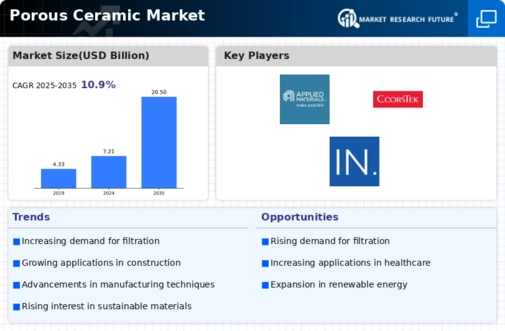Market Analysis
In-depth Analysis of Porous Ceramic Market Industry Landscape
The market dynamics of the porous ceramic industry are driven by various factors that influence supply, demand, and pricing within the market. One of the primary drivers of this market is the increasing demand for porous ceramic materials across various industries such as automotive, aerospace, healthcare, electronics, and energy. Porous ceramics offer unique properties such as high temperature resistance, corrosion resistance, thermal insulation, and filtration capabilities, making them suitable for a wide range of applications. As industries continue to seek lightweight, durable, and functional materials, there is a growing preference for porous ceramics, driving market growth in this segment.
Moreover, technological advancements in porous ceramic manufacturing processes play a significant role in shaping market dynamics. Manufacturers are continually innovating to develop new methods for producing porous ceramics with improved properties such as higher porosity, controlled pore size distribution, and enhanced mechanical strength. These advancements not only contribute to increased production efficiency but also enable the development of customized porous ceramic solutions tailored to specific applications. As technology evolves and production costs decrease, the demand for porous ceramics is expected to increase, driving market expansion in this segment.
Furthermore, the diverse range of applications for porous ceramics across different industries drives demand and market dynamics. In the automotive and aerospace industries, porous ceramics are used for catalytic converters, exhaust gas filters, thermal insulation, and lightweight structural components. In the healthcare industry, porous ceramics find applications in dental implants, bone scaffolds, drug delivery systems, and diagnostic devices. In the electronics industry, porous ceramics are used for thermal management, insulation, and electronic packaging. The wide-ranging utility of porous ceramics across industries ensures steady demand and drives manufacturers to innovate and develop new applications, further propelling market growth.
Regulatory compliance and environmental concerns also play a crucial role in shaping the porous ceramic market dynamics. Governments worldwide are implementing stricter regulations aimed at reducing emissions, promoting energy efficiency, and ensuring the safety of materials used in various industries. Porous ceramics, being inert, non-toxic, and eco-friendly materials, are gaining traction as alternatives to traditional materials such as metals, plastics, and composites. Manufacturers are responding to these regulatory requirements by developing porous ceramics that meet or exceed industry standards, thereby driving market expansion in this segment.
Competition within the porous ceramic market is intense, with several key players vying for market share. Companies differentiate themselves through product quality, innovation, technical support services, and customer relationships. Moreover, strategic partnerships, mergers, and acquisitions are common strategies employed by industry players to expand their market presence and gain a competitive edge. Additionally, pricing strategies play a crucial role in market dynamics, with manufacturers often adjusting prices in response to changes in raw material costs, competition, and market demand.
Global economic conditions and geopolitical factors also influence the porous ceramic market dynamics. Fluctuations in currency exchange rates, trade tariffs, and political instability can impact the cost of raw materials, transportation, and regulatory compliance, affecting both supply chains and pricing strategies. Furthermore, shifts in consumer preferences and purchasing power across different regions influence market demand and consumption patterns, driving manufacturers to adapt their strategies accordingly.







Leave a Comment